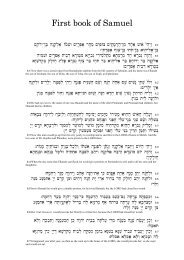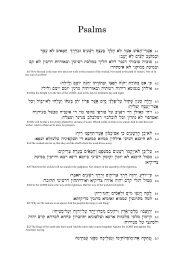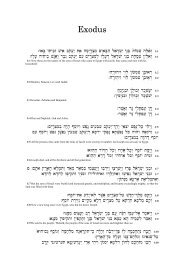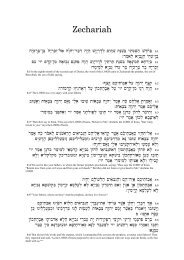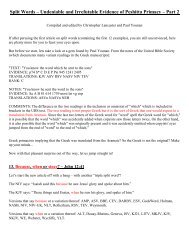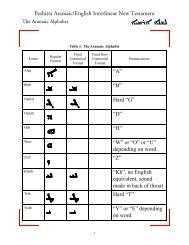ana translation
Untitled - Peshitta Aramaic/English Interlinear New Testament
Untitled - Peshitta Aramaic/English Interlinear New Testament
- No tags were found...
Create successful ePaper yourself
Turn your PDF publications into a flip-book with our unique Google optimized e-Paper software.
INTRODUCTION<br />
Ixi<br />
having preserved the original form of the text more truly than the<br />
earlier, he invokes the support of the Arabic Version, which (as above<br />
shown) was made not from the Greek but from the Philoxenian, of which<br />
Version the only known copy is supposed to be of the ninth century,<br />
older therefore than any of our manuscripts except probably Cod. 1, which<br />
bears date A.Gr. 1 134 (A.D. 823).<br />
This secondary Version, in many (yet<br />
not in all) instances, proves to agree with the readings of our later copies<br />
as embodied in the ordinary printed text ;<br />
and Dr. Merx accepts it as<br />
decisive in favour of that text against the evidence of our earlier copies.<br />
In Professor Merx's view, then, the readings in which the ordinary<br />
printed text, with the bulk of the later manuscripts of the Philoxenian,<br />
as against the text now presented, amended after the earlier manuscripts<br />
diverges from the Greek as read by all other authorities, are<br />
not mere errors of transcription in the Syriac, but represent genuine<br />
(but otherwise unattested) variants in the Greek exemplar which the<br />
Philoxenian translator has faithfully reproduced. And on the other<br />
hand, our earlier manuscripts present a text which, though more nearly<br />
conformed to that of other witnesses, is not the Philoxenian as originally<br />
issued, but as re-handled by editors who have corrected it into conformity<br />
with the Harklensian, which adheres closely to the Greek.<br />
These two opposite views of the facts presented by the manuscripts<br />
of Philoxenian text admit of an easy comparative test, addressed to<br />
the eye as well as to the understanding.<br />
SECTION XVII. Professor Merx's Theory tested by Juxtaposition of<br />
Examples of rival Readings.<br />
Let us write down, side by side, some leading examples of the readings<br />
in which the manuscripts<br />
of our later differ from those of our<br />
earlier group, placing under each the corresponding Greek, and judge<br />
in each case by inspection whether of the two hypotheses is more<br />
probable,<br />
that the Syriac as exhibited by the later group<br />
is a scribes'<br />
perversion of the earlier, or, that it represents a variant which,<br />
though found in no extant Greek manuscript and supported by no<br />
other Version, really existed in the underlying Greek.<br />
As above, in Section xn, we call the earlier group A the<br />
; later, B.<br />
It will be found that, in every case, the Syriac as given by printed<br />
texts and the B-group represents a reading of the Greek which is not<br />
known and which resembles none that is known to the Greek



